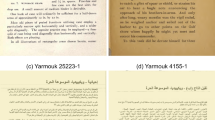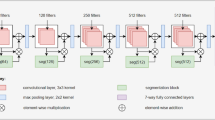Abstract
In this paper, a novel strategy based on a hybrid algorithm of Elephant Herding Optimization Big Bang–Big Crunch is provided to address the English character recognition problem with interference from external noise. A model used to recognize handwritten Hindi (Devanagari) characters is called Hindi OCR (optical character recognition). Despite the fact that only a few nature-inspired algorithms are used for OCR, none are used for the characters seen in natural scenes due to the difficulties presented by the various fonts, lighting, orientation, and texture variations. Also, Hindi’s curved and complicated architecture makes it challenging to separate and analyze the text or character. Better feature databases are created using the proposed Hybrid EHO–B3C model to facilitate categorization. Two standard datasets of English characters, Char74k and ICDAR03, are used to assess the performance of the novel Hybrid EHO–B3C on natural scene characters. The proposed model is also evaluated on the Devanagari handwritten character dataset, which is a dataset consisting of characters from the Hindi language. Results show 83% results on Char74k and 86.4% on ICDAR, comparable to most available techniques. We have also examined our algorithm for face recognition by examining it on five different datasets, namely MUCT, Faces94, Extended Yale B, Georgia Tech, and Grimace, and attained high recognition results, even though the data sets differ in size, image size, brightness and ethnicity of people.












Similar content being viewed by others
Data availability
The Char74k data used in this study is publicly accessible and can be downloaded from the http://www.ee.surrey.ac.uk/CVSSP/demos/chars74k/ website. After defining the region of study, the datasets tab allows users to directly identify and access images.
References
Al-Waisy AS, Qahwaji R, Ipson S, Al-Fahdawi S (2015) A robust face recognition system based on curvelet and fractal dimension transforms. In: 2015 IEEE international conference on computer and information technology; ubiquitous computing and communications; dependable, autonomic and secure computing; pervasive intelligence and computing
Bakkouri I, Afdel K (2020) Computer-aided diagnosis (CAD) system based on multi-layer feature fusion network for skin lesion recognition in dermoscopy images. Multimed Tools Appl 79:20483–20518
Bakkouri I, Afdel K (2023) MLCA2F: multi-level context attentional feature fusion for COVID-19 lesion segmentation from CT scans. Signal Image Video Process 17:1181–1188
Bansal S (2018) Nature-inspired-based multi-objective hybrid algorithms to find near-OGRs for optical WDM systems and their comparison. In: Handbook of research on biomimicry in information retrieval and knowledge management. IGI Global
Bansal S, Sharma K (2018) Nature-inspired-based modified multi-objective BB–BC algorithm to find near-OGRs for optical WDM systems and its performance comparison. In: Handbook of research on biomimicry in information retrieval and knowledge management. IGI Global
Bansal S, Gupta N, Singh AK (2021) Application of bat-inspired computing algorithm and its variants in search of near-optimal Golomb rulers for WDM Systems: a comparative study. In: Dey N, Rajinikanth V (eds) Applications of bat algorithm and its variants. Springer tracts in nature-inspired computing. Springer, Singapore
Chandio AA, Pickering M, Shafi K (2018) Character classification and recognition for Urdu texts in natural scene images. In: 2018 international conference on computing, mathematics and engineering technologies (iCoMET)
Chhabra S, Singh R, Vatsa M, Gupta G (2018) Anonymizing k-facial attributes via adversarial perturbations. arXiv preprint arXiv:1805.09380
Chu WS, Chen JC, Lien JJ (2011) Kernel discriminant transformation for image set-based face recognition. Pattern Recognit 44:1567–1580
De Campos TE, Babu BR, Varma M et al (2009) Character recognition in natural images. In: VISAPP (2)
Deshpande NT, Ravishankar S (2017) Face detection and recognition using Viola–Jones algorithm and fusion of PCA and ANN. Adv Comput Sci Technol 10:1173–1189
Erol OK, Eksin I (2006) A new optimization method: big bang–big crunch. Adv Eng Softw 37:106–111
Feild JL, Learned-Miller EG (2013) Improving open-vocabulary scene text recognition. In: 2013 12th international conference on document analysis and recognition
Hamdan YB et al (2021) Construction of statistical SVM based recognition model for handwritten character recognition. J Inf Technol 3:92–107
Iwamura M, Kobayashi T, Kise K (2011) Recognition of multiple characters in a scene image using arrangement of local features. In: 2011 international conference on document analysis and recognition
Jaderberg M, Vedaldi A, Zisserman A (2014) Deep features for text spotting. In: European conference on computer vision
Kowsalya S, Periasamy PS (2019) Recognition of Tamil handwritten character using modified neural network with aid of elephant herding optimization. Multimed Tools Appl 78:25043–25061
Lee C-Y, Bhardwaj A, Di W, Jagadeesh V, Piramuthu R (2014) Region-based discriminative feature pooling for scene text recognition. In: Proceedings of the IEEE conference on computer vision and pattern recognition
Li X, Yin M (2012) Multi-operator based biogeography based optimization with mutation for global numerical optimization. Comput Math Appl 64:2833–2844
Lucas SM, Panaretos A, Sosa L, Tang A, Wong S, Young R, Ashida K, Nagai H, Okamoto M, Yamamoto H et al (2005) ICDAR 2003 robust reading competitions: entries, results, and future directions. Int J Doc Anal Recognit (IJDAR) 7:105–122
Mathew M, Singh AK, Jawahar CV (2016) Multilingual OCR for Indic scripts. In: 2016 12th IAPR workshop on document analysis systems (DAS)
Nanda PK, Goswami L (2016) Image processing application in character recognition. Mater Today Proc 81:520–523
Nebti S, Boukerram A (2013) Handwritten characters recognition based on nature-inspired computing and neuro-evolution. Appl Intell 38:146–159
Nefian AV (2002) Embedded Bayesian networks for face recognition. In: Proceedings IEEE international conference on multimedia and expo
Neumann L, Matas J (2010) A method for text localization and recognition in real-world images. In: Asian conference on computer vision
Ning J, Zhang L, Zhang D, Wu C (2009) Robust object tracking using joint color-texture histogram. Int J Pattern Recognit Artif Intell 23:1245–1263
Pramanik R, Bag S (2018) Shape decomposition-based handwritten compound character recognition for Bangla OCR. J Vis Commun Image Represent 50:123–134
Shonak B (2019) A comparative study of nature-inspired metaheuristic algorithms in search of near-to-optimal Golomb rulers for the FWM crosstalk elimination in WDM systems. Appl Artif Intell 33:1199–126
Shonak B (2020) Performance comparison of five metaheuristic nature-inspired algorithms to find near-OGRs for WDM systems. Artif Intell Rev 53:5589–5635
Silva EM, Boaventura M, Boaventura IAG, Contreras RC (2018) Face recognition using local mapped pattern and genetic algorithms
Singh S (2013) Optical character recognition techniques: a survey. J Emerg Trends Comput Inf Sci 4:13
Su B, Lu S, Tian S, Lim JH, Tan CL (2014) Character recognition in natural scenes using convolutional co-occurrence hog. In: 2014 22nd international conference on pattern recognition
Tian S, Bhattacharya U, Lu S, Su B, Wang Q, Wei X, Lu Y, Tan C (2016) Multilingual scene character recognition with co-occurrence of histogram of oriented gradients. Pattern Recognit 51:125–134
Vedaldi A, Fulkerson B (2014) Deep features for text spotting. In: Brian proceedings of the 18th ACM international conference on multimedia
Vinay A, Gupta A, Bharadwaj A, Srinivasan A, Murthy KB, Natarajan S (2018) Unconstrained face recognition using Bayesian classification. Procedia Comput Sci 143:519–27
Wang K, Babenko B, Belongie S (2011) Serge end-to-end scene text recognition. In: 2011 international conference on computer vision
Wang K, Belongie S (2010) Word spotting in the wild. In: European conference on computer vision
Wang X, Jiang Y, Yang S, Zhu X, Li W, Fu P, Wang H, Luo Z (2017) End-to-end scene text recognition in videos based on multi frame tracking. In: 2017 14th IAPR international conference on document analysis and recognition (ICDAR)
Zandi Z, Afjei E, Sedighizadeh M (2013) Hybrid big bang–big crunch optimization based optimal reactive power dispatch for voltage stability enhancement. J Theor Appl Inf Technol 47:537–546
Zhang K, Zhang L, Yang M-H, Hu Q (2013) Robust object tracking via active feature selection. IEEE Trans Circ Syst Video Technol 23:1957–1967
Zhang Z, Xu Y, Liu C-L (2016) Natural scene character recognition using robust PCA and sparse representation. In: 2016 12th IAPR workshop on document analysis systems (DAS)
Funding
The authors did not receive support from any organization for the submitted work.
Author information
Authors and Affiliations
Corresponding author
Ethics declarations
Conflict of interest
The authors declared that they have no conflict of interest.
Additional information
Publisher's Note
Springer Nature remains neutral with regard to jurisdictional claims in published maps and institutional affiliations.
Rights and permissions
Springer Nature or its licensor (e.g. a society or other partner) holds exclusive rights to this article under a publishing agreement with the author(s) or other rightsholder(s); author self-archiving of the accepted manuscript version of this article is solely governed by the terms of such publishing agreement and applicable law.
About this article
Cite this article
Goel, L., Kanhar, J., Patel, V.S. et al. Hybrid Elephant Herding Optimization–Big Bang Big Crunch for pattern recognition from natural images. Soft Comput 28, 3431–3447 (2024). https://doi.org/10.1007/s00500-023-08667-y
Accepted:
Published:
Issue Date:
DOI: https://doi.org/10.1007/s00500-023-08667-y




